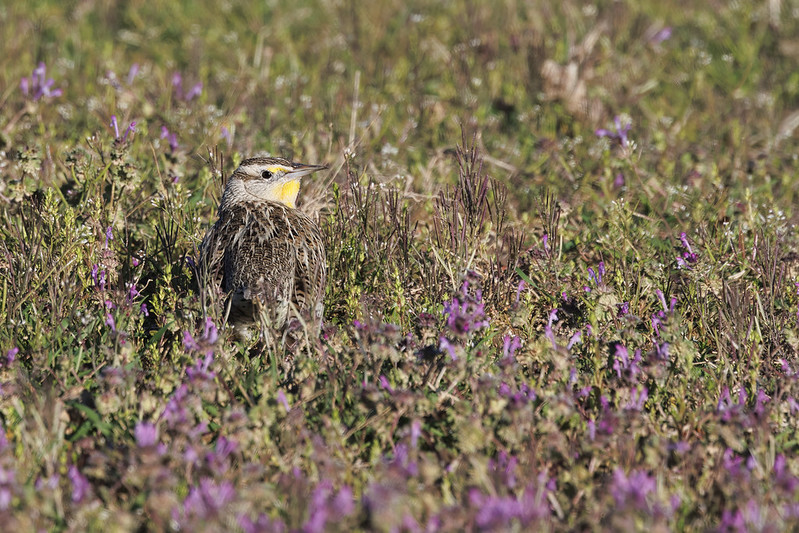It seems like there is a mistake in my blog post regarding the identification of the meadowlark in my photo. According to a bird ID expert (Jim Arterburn), the bird in the photo is a Western Meadowlark, not an Eastern Meadowlark. The expert pointed out that the yellow on the throat extends up into the malar area, which is a characteristic feature of the Western Meadowlark.
It’s also worth noting that the expert mentioned that Western Meadowlarks seem to prefer henbit more than Eastern Meadowlarks, which is an interesting observation.
While driving near the front of the Sequoyah National Wildlife Refuge in Oklahoma, I spotted a Western Meadowlark in a field of flowers close to the auto tour road. I had always wanted to capture a photograph of these beautiful birds among the flowers that bloom in these fields at this time of year. However, my hopes seemed slim as the farmers were about to plant in these fields, and the flowers would soon disappear.
Luckily, I managed to capture a shot of this stunning bird just as a pickup truck was driving by. Meadowlarks are a bird species that are commonly found in open fields, grasslands, and meadows throughout North America.

Facts About The Western Meadowlark:
- The Western Meadowlark is a medium-sized bird species that belongs to the blackbird family. It is known for its distinctive, flute-like song, which is often heard in grasslands and meadows across western North America.
- The Western Meadowlark is the state bird of six U.S. states: Kansas, Montana, Nebraska, North Dakota, Oregon, and Wyoming.
- Male Western Meadowlarks have a bright yellow breast with a distinctive black V-shaped bib on their chest, while females have a duller yellow or brownish breast.
- Western Meadowlarks are ground-nesting birds, building their nests in grassy areas or agricultural fields. They are known to sometimes reuse old nests or take over the nests of other birds.
- Western Meadowlarks have a varied diet that includes insects, seeds, and occasionally small vertebrates like mice or lizards.
- These birds are known for their elaborate displays during courtship, which involve the male flying into the air and singing while fluttering his wings and tail feathers.
- The Western Meadowlark was once considered to be the same species as the Eastern Meadowlark, but they were later separated due to differences in their songs, appearance, and genetics.
- The Western Meadowlark is a long-distance migrant, with some populations traveling up to 3,000 miles each year between their breeding and wintering grounds.
- While Western Meadowlark populations are generally stable, they are still threatened by habitat loss due to agricultural and urban development, as well as pesticide use and climate change.
- The scientific name of the Western Meadowlark is Sturnella neglecta, with “Sturnella” meaning “little starling” and “neglecta” meaning “neglected” or “overlooked”. This name was given due to the bird’s resemblance to starlings and the fact that it was initially overlooked as a separate species.
Gear Used:
- Camera: Canon EOS R7
- Lens: Canon RF 100-500 mm F4.5-7.1 L IS USM
Technical:
I was photographed this Western Meadowlark from inside my pickup. I had a beanbag draped over the open window to support my camera and lens.
- Location: Sequoyah National Wildlife Refuge (Oklahoma)
- Date and Time Taken: March 17, 2023 (09:15 A. M.)
- Exposure Mode: Manual
- Aperture: f8
- Shutter speed: 1/1600
- ISO: 640 (Auto)
- Focal Length: 500 mm
